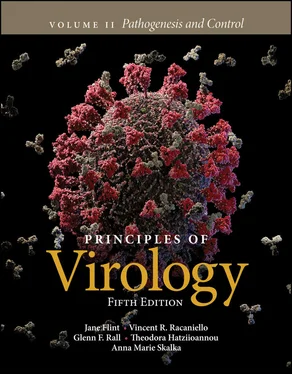S. Jane Flint - Principles of Virology, Volume 2
Здесь есть возможность читать онлайн «S. Jane Flint - Principles of Virology, Volume 2» — ознакомительный отрывок электронной книги совершенно бесплатно, а после прочтения отрывка купить полную версию. В некоторых случаях можно слушать аудио, скачать через торрент в формате fb2 и присутствует краткое содержание. Жанр: unrecognised, на английском языке. Описание произведения, (предисловие) а так же отзывы посетителей доступны на портале библиотеки ЛибКат.
- Название:Principles of Virology, Volume 2
- Автор:
- Жанр:
- Год:неизвестен
- ISBN:нет данных
- Рейтинг книги:3 / 5. Голосов: 1
-
Избранное:Добавить в избранное
- Отзывы:
-
Ваша оценка:
- 60
- 1
- 2
- 3
- 4
- 5
Principles of Virology, Volume 2: краткое содержание, описание и аннотация
Предлагаем к чтению аннотацию, описание, краткое содержание или предисловие (зависит от того, что написал сам автор книги «Principles of Virology, Volume 2»). Если вы не нашли необходимую информацию о книге — напишите в комментариях, мы постараемся отыскать её.
Volume I: Molecular Biology
Volume II: Pathogenesis and Control
Principles of Virology, Fifth Edition
Principles of Virology, Volume 2 — читать онлайн ознакомительный отрывок
Ниже представлен текст книги, разбитый по страницам. Система сохранения места последней прочитанной страницы, позволяет с удобством читать онлайн бесплатно книгу «Principles of Virology, Volume 2», без необходимости каждый раз заново искать на чём Вы остановились. Поставьте закладку, и сможете в любой момент перейти на страницу, на которой закончили чтение.
Интервал:
Закладка:
Koch’s postulates helped to identify causal relationships between a microbe and the disease it causes in the host, although these postulates may not be fulfilled when associating some viruses with a particular disease.
Major insights in viral pathogenesis have come from exploitation of technical advances in the fields of molecular biology and immunology.
The increased mobility of human and animal populations on the planet has accelerated the emergence of epidemics.
Many viruses that can infect multiple species establish a reservoir in an animal host in which the virus causes negligible disease. Spread into new human hosts, called a zoonosis, is usually a dead-end infection.
Epidemiology, the study of infections in populations, is the cornerstone of public health research and response.
Individual differences among prospective hosts, group dynamics and behaviors, geography, and climate all influence how efficiently a virus can establish infection within a population.
The regional occurrence of viral infections may be due to the restriction of a vector or animal reservoir to a limited geographical area.
Seasonal differences in the appearances of some viruses may be due to variations in viral particle stability at various temperatures or humidity, changes in the integrity of host barriers (such as the skin or mucosa), or seasonal changes in the life cycles of viral vectors, such as mosquitos.
Susceptibility to infection does not necessarily signify susceptibility to disease.
A Brief History of Viral Pathogenesis
The Relationships among Microbes and the Diseases They Cause
Long before any disease-causing microbes were identified, poisonous air (miasma) was generally presumed to cause epidemics of contagious diseases. The causative association of particular microorganisms, initially bacteria, with specific diseases can be attributed to the work of the German physician Robert Koch. With his colleague Friedrich Loeffler, Koch developed four criteria that, if met, would prove a causal relationship between a given microbe and a particular disease. These criteria, Koch’s postulates, were first published in 1884 and are still used today as a standard by which pathogens are identified. The postulates are as follows:
the microorganism must be associated regularly with the disease and its characteristic lesions but should not be found in healthy individuals;
the microorganism must be isolated from the diseased host and grown in culture;
the disease should be reproduced when a pure preparation of the microorganism is introduced into a healthy, susceptible host; and
the same microorganism must be reisolated from the experimentally infected host.
Guided by these postulates and the methods developed by Pasteur for the sterile culture and isolation of purified preparations of microorganisms, researchers identified and classified many pathogenic bacteria (as well as yeasts and fungi) during the latter part of the 19th century. Identifying a cause-and-effect relationship between a microbe and a pathogenic outcome set the stage for transformative therapeutic advances, including the development of antibiotics to treat bacterial infections.
However, during the last decade of the 19th century, it became clear that not all diseases could be attributed to bacterial or fungal agents. This apparent breakdown of the paradigm led to the identification of a new class of infectious agents: submicroscopic particles that came to be called viruses. Koch’s postulates can often be applied to viruses, but not all virus-disease relationships meet these criteria. While compliance with Koch’s principles willestablish that a particular virus is the causative agent of a specific disease, failure to comply does not rule out a possible cause-and-effect relationship ( Box 1.1).
BOX 1.1
DISCUSSION
Why viruses may not fulfill Koch’s postulates
Although Koch’s postulates provided a framework to identify a pathogen as an agent of a particular disease unambiguously, not all postulates can be applied to some infectious agents of disease. Koch himself became aware of the limitations of his postulates upon discovery that the bacterium Vibrio cholerae , which causes cholera, could be isolated from both sick and healthy individuals . In fact, it has been argued that the rigid application of these criteria to viral agents may have impeded early progress in the field of virology.
Application of Koch’s postulates to viruses can be problematic for several reasons . For example, the first postulate, which states that the microorganism must be “regularly associated” with the disease, does not hold true for many animal reservoirs, such as bats, in which the virus actively reproduces but causes no disease. Similarly, arthropod vectors, such as mosquitos, support reproduction of a variety of hemorrhagic viruses but do not die as a result. Moreover, the second postulate states that the microorganism must be grown in culture. However, some viruses, including papilloma-viruses that cause warts and cervical cancer, could be propagated in culture only recently, requiring complex conditions that must mimic the tissue complexity found in the infected host. Finally, recent studies addressing polymicrobial infections (that is, infections with more than one pathogen) have shown that, for some diseases, two or more organisms must work in synergy to cause a disease.

Highly sensitive molecular technologies, including quantitative polymerase chain reaction and DNA sequencing, have triggered a revision of Koch’s postulates for the modern era. Left panel courtesy of Granger Historical Picture Archive, image no. 0008494.
Assiduously applying the postulates has been particularly problematic for identifying viruses that cause human tumors . As noted in a review, Koch’s postulates “are a brilliant example of precision in scientific thinking, but they hold little practical value for 21st century tumor virology, as they cannot prove nor disprove most candidate tumor viruses to cause cancers.” Consequently, the postulates are a guide, not an invariant set of requirements to fulfill.
More recently, detection methods based on nucleic acid sequence have rendered Koch’s original postulates even less relevant. Such approaches are sufficiently sensitive to detect the presence of small quantities of viral nucleic acid in an apparently healthy individual. As such, a revised set of Koch’s postulates that takes into consideration new technical capabilities has been proposed (Volume I, Box 1.4).
Fredricks DN, Relman DA. 1996. Sequence-based identification of microbial pathogens: a reconsideration of Koch’s postulates. Clin Microbiol Rev 9:18– 33.
Moore PS, Chang Y. 2014. The conundrum of causality in tumor virology: the cases of KSHV and MCV. Semin Cancer Biol 26:4–12.
The First Human Viruses Identified and the Role of Serendipity
The first human virus that was identified was the agent that causes yellow fever. The story of its identification in 1901 is instructive, as it highlights the contributions of creative thinking, collaboration, serendipitous timing, and even heroism in identifying new pathogens.
Although not recognized, yellow fever was widespread in tropical countries since the 15th century, and was responsible for devastating epidemics associated with extraordinary rates of mortality (for example, over a quarter of infected individuals died in the New Orleans epidemic of 1853). While the disease can be relatively mild, with transient symptoms that include fever and nausea, more-severe cases result in major organ failure. Destruction of the liver causes yellowing of the skin (jaundice), the symptom from which the disease name is derived. Despite its impact, little was known about how yellow fever was spread, although it was clear that the disease was not transferred directly from person to person. This property prompted speculation that the source of the infection was present in the atmosphere, and led to desperate efforts to “purify” the air, including burning barrels of tar and firing cannons. Some believed that the pathogen was carried on fomites, such as bedding or clothing, although this hypothesis was disproved when volunteers remained healthy after sleeping in the nightwear of yellow fever victims.
Читать дальшеИнтервал:
Закладка:
Похожие книги на «Principles of Virology, Volume 2»
Представляем Вашему вниманию похожие книги на «Principles of Virology, Volume 2» списком для выбора. Мы отобрали схожую по названию и смыслу литературу в надежде предоставить читателям больше вариантов отыскать новые, интересные, ещё непрочитанные произведения.
Обсуждение, отзывы о книге «Principles of Virology, Volume 2» и просто собственные мнения читателей. Оставьте ваши комментарии, напишите, что Вы думаете о произведении, его смысле или главных героях. Укажите что конкретно понравилось, а что нет, и почему Вы так считаете.



